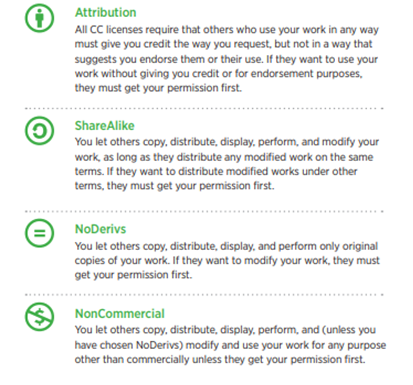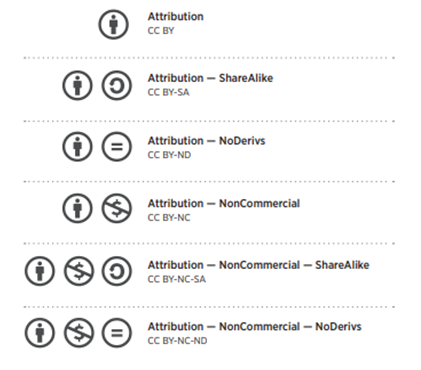8. Licensing
Authors:
- Anna Swan :custom-orchid:
- Alexandra Holinski
Description
This chapter will explain how you can encourage use and reuse of training materials through choosing appropriate licences. It will cover the different licence options available to date and consider the implications for users. It will also explain the practicalities of implementing your chosen licences and give an awareness of common issues to consider.
Prerequisites
Learners should have material that they would like to share and consider attaching a licence to.
Learning Outcomes
- List the differences between the various licence schemes and licence types
- Describe the implications for users of materials and how this impacts on your choice
What are licences and why are they required?
Licences are a standardised way of giving others specific permissions to use work you created. They allow you to put your work out publicly, while providing guidance to users about how they can use your materials and whether there are any restrictions.
As discussed a few times now in previous chapters, making your training materials public, others can benefit from your work and experience. It also benefits you as it increases the possibility of your materials being used in the way you would like and in a way that provides you with credit for your work. By attaching a licence to your materials, you get to keep some control over how they can be used. For example, you may be happy for anyone to use your materials, provided you are credited, or perhaps you would like to allow anyone to use the materials, but only if they make no changes to them. Selecting the right licence allows you to make these choices and communicate them to your users.
It’s important to remember that not having a licence assigned does not mean that anyone is allowed to do anything with the material, but instead creates confusion around what is allowed.
Licence schemes
There are many different licensing schemes available, each with different types of licences that allow you to choose what users of your materials can do with them.
Some common licensing schemes include Creative Commons, MIT License, Apache, and GNU General Public License.
The most common type of licence used for training materials is Creative Commons and we’ll discuss these further later on in this chapter.
Your choice of scheme and licence will depend on a number of factors, such as the type of materials, who the materials are targeted at, what you anticipate users wanting your materials for, any rules your institute may have already, and any materials you include within yours.
Learning activity: find some examples of licences on training materials
This learning activity will help you think more critically about how licences can be used.
- Find three examples of training materials that include a licence
- Do they all use the same licence scheme or type of licence?
- Are you clear on how you can use the materials or do you require more information?
- Were the licences easy to spot?
Creative Commons licences
There are four conditions which can be applied to your materials by Creative Commons licences 1:

These four conditions can be combined to make up six different types of Creative Commons licences for you to choose for your materials:

You can label your materials with the above logos to help users quickly know which licence you have applied to your materials. Logo images are available for download from Creative Commons.
There is also the option to use CC0 which allows you to put materials in the public domain, meaning users can do whatever they like with the materials, with no conditions attached.
Before adding a licence to your training materials, it is important to keep in mind that licences cannot be revoked. The materials will remain covered by the licence you chose, even if you decide to stop distributing the materials later on.
Learning activity: choosing a licence
To help you decide which licence is most suitable for your materials, Creative Commons provides a licence chooser. In the following activity, you will try out the Creative Commons licence chooser for yourself.
- Select some of your training materials that you would like to add a licence to.
- Try the Creative Commons Licence Chooser to determine which licence is most suitable for your selected materials.
- Consider the licence the Chooser identified, do you think it is suitable for your materials? Remember, you may also need to consider requirements and restrictions set by your institute or company.
Attaching a licence to your materials
Once you have chosen a licence for your materials, you need to ensure you communicate that licence to all users of your materials.
Logos and images that illustrate the chosen licence can be a great way of adding the licence to your materials. But to make sure all users understand what the licence means, you should add a link to the page that details the licence where possible. For example, if you use a CC-BY licence, link to the relevant page on the Creative Commons website.
Reusing licenced materials
If you wish to reuse someone else’s materials you must first check that the licence they have applied to them allows it. You will also need to ensure that you recognise and cite their work appropriately (see Chapter 10).
The licence that you can apply to the new version of the materials depends on the original licence and how you have changed, adapted or remixed the materials. Creative Commons provides a guide on how to do this in different situations.
Checklist
- Clearly label your materials with the chosen licence
- Include your contact information in case anyone needs to ask you any questions about your materials or their use
- Cite any other creators’ materials that you include in yours - do not reuse others’ works if you are not sure about their permissions
- Check with your institute/company if there are any specific licence rules or guidance
Next steps
Choosing an appropriate licence is an important step in encouraging appropriate recognition of your work and encouraging contributions and collaborations. Read more about recognition and contributions to training materials in Chapter 10.
-
When we share, everyone wins. Accessed: 2022-08-11. URL: https://creativecommons.org/. ↩